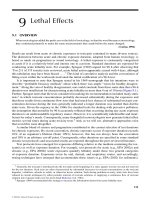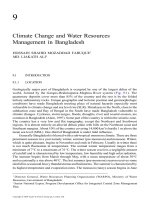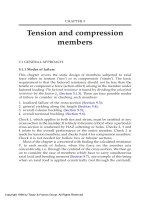EC&M’s Electrical Calculations Handbook - Chapter 9 docx
Bạn đang xem bản rút gọn của tài liệu. Xem và tải ngay bản đầy đủ của tài liệu tại đây (441.74 KB, 32 trang )
Transformers
While direct-current (dc) systems are essentially “stuck”
with the source voltage (with only a very few exceptions),
alternating-current (ac) systems offer great flexibility in
voltage due to magnetic coupling in transformers. As their
name implies, transformers are used in ac systems to trans-
form, or change, from one voltage to another.
Since transformers are among the most common types of
devices in electrical power systems, second only to wires and
cables, specific attention is paid to designing electrical sys-
tems that contain these devices.
In its simplest form, a transformer consists of two coils
that are so near to one another that the magnetic flux
caused by exciting current in the first, or primary, coil cuts
the three-dimensional space occupied by the second coil,
thereby inducing a voltage in the second coil. With this
action, it is essentially acting just like a generator’s rotating
magnetic field. The voltage imparted to the second coil can
be calculated simply by the ratio
ϭ
V
P
ᎏ
V
S
N
P
ᎏ
N
S
Chapter
9
251
Copyright 2001 by The McGraw-Hill Companies, Inc. Click here for Terms of Use
where N
P
ϭ the number of turns in the primary coil
N
S
ϭ number of turns in the secondary coil
V
P
ϭ voltage measured across the primary coil ter-
minals
V
S
ϭ voltage generated in the secondary coil
Figure 9-1 is a sample calculation showing how to deter-
mine what the voltage will be out of the secondary terminals
of a transformer with a given input voltage connected to the
primary coil terminals.
Some transformers are more robust than others, and the
amount of electrical abuse that a transformer can withstand
is closely related to the method of heat removal employed
within the transformer. A given transformer that can carry
load x when cooled by convection air can carry more than x
when cooled by an auxiliary fan. Further, when the trans-
former coils are immersed in an insulating liquid such as
mineral oil, internal heat is dispersed and hot spots are
minimized. Thus liquid cooling permits given sizes of trans-
former coils to carry much more load without damage.
Moreover, some transformers are insulated with material
that can remain viable under much hotter temperatures
than others. All these things increase the load-carrying
capability of transformers:
■
Convective air circulation
■
Forced fan air circulation
■
Coil immersion in an insulating liquid
■
Convective air circulation around oil cooling fins
■
Forced fan air circulation around oil cooling fins
■
The addition of two or three sets of oil cooling fins
■
Forced pumping of insulating liquid through cooling fins
■
Coil insulation of a higher temperature rating
Liquid-filled transformers are always base rated accord-
ing to their load-carrying capability by convective air circu-
lation around the transformer and around the first set of
252 Chapter Nine
Figure 9-1
Solve for transformer output voltage given input
voltage and turns
ratio.
253
cooling fins if the transformer normally is equipped with
these cooling fins as standard equipment. Normally, liquid-
filled transformers are rated at the highest temperature
that the insulation system can withstand over a long period
without degrading prematurely.
Figure 9-2 is a sample calculation showing how much
additional load-carrying capability a transformer of a given
size can gain when some of the more usual auxiliary cooling
methods are applied. A transformer that is rated OA
55°C/FA 65°C can carry 12 percent more load when permit-
ted to rise to 65°C, even without the cooling fans in opera-
tion. How much each of the more usual insulation systems
and auxiliary cooling methods can increase transformer
load capabilities is shown in Fig. 9-2, and the resulting
transformer kilovoltampere ratings and full-load current
ratings are shown in Fig. 9-3. Note that the percentage
increase is different for very large transformers when com-
pared with transformers in the 1000-kilovoltampere (kVA)
range. Also note that the transformer rating is the 24-hour
average load rating and that it can be exceeded somewhat
for short periods without deleterious effects.
There are a great many types of transformer ratings, and
some are more usual than others. A summary of these rat-
ings is given at the top of Fig. 9-2.
All the things just stated about transformers are predi-
cated on the transformer being in operation with a sinu-
soidal voltage of the exact frequency for which the
transformer is designed and at approximately the voltage
for which the transformer is designed. If the voltage is
reduced, maintaining the kilovoltampere level requires
increased current flow, thus tending to overheat the trans-
former. If the voltage is increased too much, too much excit-
ing current flows, and core magnetic saturation occurs. This
also causes transformer overheating. Operating a trans-
former in an electrical system having a large value of volt-
age distortion and/or current distortion also causes
transformer overheating due to increased eddy current flow
and greatly increased hysteresis losses.
254 Chapter Nine
In electrical systems having nonsinusoidal currents and
voltages, either the use of greatly oversized transformers or
special transformers with K-ratings is required to handle all
the extra heat generated within the transformers. A K-rating
of 8 on a transformer nameplate means that the transformer
can safely carry a specific nonsinusoidal kilovoltampere load
that would heat a non-K-rated transformer to the same tem-
perature as if it were carrying a load that was eight times
larger. This is due to additional eddy current core losses and
conductor heating losses due to skin-effect current flow at
the higher frequencies. Figure 3-27 shows how to calculate
the transformer K-rating requirements for a given load con-
taining harmonics.
In calculating the required K-rating of a transformer, the
first thing that is necessary is to determine the magnitudes
and frequencies of the currents that the transformer must
carry. These are normally stated in terms of amperes at
each harmonic or multiple of the first-harmonic base fre-
quency, but sometimes the currents are stated as a percent-
age of the fundamental frequency. The first harmonic (i.e.,
the fundamental frequency) is 60 in a 60-hertz (Hz) system,
and it is 50 in a 50-Hz system.
Three-Phase Transformers
Most of the transformers in operation in the electrical pow-
er systems of the world today are three-phase transformers.
This is so largely because of economics and partly because of
the innate rotating flux provided by three-phase systems in
electrical motors. Given the correct coil-winding equipment
and design software, almost any voltage can be created with
three-phase transformers, but there are only a few standard
transformer connections that are used frequently, and they
are summarized here for American National Standards
Institute/National Electrical Manufacturers Association
(ANSI/NEMA) installations as well as for International
Electrotechnical Commission (IEC) installations and
Australian designs.
Transformers 255
256
Figure 9-2
Solve for oil-filled transformer kilovoltampere
capability given
increased insulation temperature capability and
with added cooling systems.
257
Figure 9-3
Solve for transformer full-load current values
for common kilo-
voltampere transformer ratings at common system
voltage values.
258
Three-phase delta
Figure 9-4 shows the connections of the three individual
coils of a generator connected as single-phase units. It also
shows an improvement on the single-phase connection by
adding jumpers at the generator that connect the three sin-
gle-phase coils into a delta configuration. In the delta con-
figuration, each phase appears to be an individual
single-phase system, while together the three single-phase
systems combine to provide three times the load capability
while eliminating three circuit conductors and reducing the
size of the remaining wires to 70.7 percent of the size of the
former single-phase conductors. In the delta connection, the
phase-to-phase voltage is also the coil voltage.
An identical connection is made at a three-phase trans-
former, where all three coils are connected end to end, with
one “phase” wire brought out at every end-to-end joint, and
the 120 electrical degree voltage displacement is faithfully
displayed in vector form on graph paper in the shape of the
Greek letter delta. Figure 9-5 shows the wiring connections
of the three phases at the generator and at three-phase
motors and single-phase loads. There are two basic prob-
lems with delta systems:
Transformers 259
Liquid-filled transformers can carry extra power when fitted with
cooling stages.
260
Figure 9-4
Solve for wiring connections from a wye-connected
generator to a
wye-connected or delta-connected motor.
261
262
Figure 9-5
Solve for motor coil voltage given delta-connected
generator coil
voltage and wiring connection diagram.
263
■
They offer no lower voltage for smaller loads.
■
Grounding, if done, must be done at one phase, thus
increasing voltage stress on the insulation of the other
two phases.
For these reasons, wye connections are often used.
Figure 9-6 shows how to solve for the motor coil voltage
from a wye-connected generator whose coil voltage is 120
volts (V). The steps are to diagram the system under analy-
sis first and then to sketch the generator coil voltages. Next,
sketch the voltage vectors to be added, and then transform
the voltage vectors to the rectangular coordinate form so
that they can be added. Finally, the resulting voltage sum is
converted back into polar form, showing that in a wye-con-
nected system the phase-to-phase voltage is equal to the coil
voltage multiplied by the square root of 3.
Three-phase wye
Figure 9-4 showed the connections of the three individual
generator coils connected as single-phase units. Figure 9-7
improves on the single-phase connection by adding jumpers
at the generator that connect the three single-phase coils
into a wye configuration. In the wye configuration, as was
true in the delta configuration, each phase appears to be an
individual single-phase system, while together the three
single-phase systems combine to provide three times the
load capability while eliminating three circuit conductors
and reducing the size of the remaining wires to approxi-
mately two-thirds of the size of the former single-phase con-
ductors. In addition, the wye system offers a “neutral” point
at which grounding of the system is convenient and func-
tional without voltage overstressing anywhere in the sys-
tem, and the “neutral” grounded conductor provides a path
for imbalance current to return to the source while provid-
ing a phase-to-neutral coil voltage source applicable for use
with smaller loads at lower voltage.
As at a wye-connected generator, an identical connection
is made at a three-phase wye-connected transformer, where
264 Chapter Nine
all three coils are connected at one end to form the neutral
grounding point, and the 120 electrical degree voltage dis-
placement is faithfully displayed in vector form beside the
transformer symbol on the electrical one-line drawing in the
shape of the letter Y. This is shown on Fig. 9-7, which also
shows the connections of the three phases at both a three-
phase motor and at a single-phase load, as well as at a line-
to-neutral load.
Figure 9-8 shows many of the most common transformer
connections, along with their voltages, for both 50- and 60-
Hz systems around the world.
Frequently, slight modification of the voltage is needed for
proper operation of load appliances. Changing voltage can
be done easily by using multiple “taps” at the transformer to
increase or decrease the output voltage. Generally, when
taps are provided, there are two 2.5 percent taps above and
below the center voltage. Figure 9-9 shows how to change
the output voltage by simply changing taps at the trans-
former coils.
Overcurrent Protection of Transformers
All electrical equipment must be protected against the
effects of both short-circuit current and long-time overload
current, and transformers are no exception. Although trans-
formers are quite tolerant to short-time overloads because of
their large thermal mass (since it takes a long time for the
transformer to heat when subjected to long-time overloads),
specific rules regarding the maximum overcurrent device
settings for most electrical power transformers are set out in
Tables 450-3(a) and (b) of the National Electrical Code.
These tables and the rules that refer to them apply to a
bank of single-phase transformers connected to operate as a
single unit, as well as to individual single-phase or three-
phase units operating alone.
Where an overcurrent device on the transformer sec-
ondary is required by these rules, it can consist of not more
than six circuit breakers or sets of fuses grouped in one loca-
tion. Where multiple overcurrent devices are used, the total
Transformers 265
266 Chapter Nine
Figure 9-6 Solve for motor coil voltage in a delta-connected motor given
the source is a wye-connected generator with a 120-V coil voltage.
Transformers 267
268
Figure 9-7
Solve for the connection diagram of a wye-connected
transformer
secondary to one-phase and to balanced and unbalanced
three-phase loads.
269
270 Chapter Nine
Figure 9-8 Solve for the correct voltage and matching trans-
former connection configuration for common 50- and 60-Hz
systems.
Transformers 271
Figure 9-9
The transformer output voltage can be adjusted
by switching to dif-
ferent “taps” of the transformer coil.
272
of all the devices ratings must not exceed the allowed value
of a single overcurrent device. If both circuit breakers and
fuses are used as the overcurrent device, the total of the
device ratings must not exceed that allowed for fuses.
Note that these rules are only for the protection of the
transformer and do not apply to protection of the conductors
to or from the transformer. For protection of the transformer
feeder conductors, compliance with the rules for conductor
protection found in Article 240 of the National Electrical
Code is required.
For transformers having at least one coil
operating at over 600 V
Transformers that have at least one coil operating at over
600 V must have overcurrent protection on both their pri-
mary and secondary. The rating of each overcurrent device
is provided in Table 450-3(a) of the National Electrical Code,
and for the reader’s convenience, it is replicated in Fig. 9-10.
The general rule is that when the required overcurrent
device rating does not correspond to a standard rating, use
of the next-higher standard rating is permitted. The sec-
ondary overcurrent device can be one to six overcurrent
devices, but the sum of their ratings must not exceed the
value shown in the table. Other specific cases are mentioned
in the code where these rating rules are relaxed somewhat,
but these are left to the reader to explore in the code. A sam-
ple calculation showing the application of these rules is
shown in Fig. 9-11.
For transformers operating at below 600 V
When all coil voltages are below 600 V, the basic rule in
transformer overcurrent protection is for the overcurrent
protective device on the primary of the transformer to be rat-
ed at 125 percent of the rated full-load primary transformer
current. There are three minor exceptions to this rule, and
all four rules are shown in Table 450-3(b) of the National
Electrical Code, replicated in Fig. 9-12 on p. 278. A sample
calculation using this table is shown in Fig. 9-13 on p. 279.
Transformers 273
Figure 9-10
Table replicating part of NEC Table 450-3(a),
overcurrent protec-
tion of transformers over 600 V.
274
In many calculations, such as circuit breaker selection
and harmonic resonance scans, the reactance/resistance
ratio, or X/R ratio, of a transformer is required. The X/R val-
ue of a transformer can be determined either from a graph
or from a unique calculation. See Fig. 9-14 on p. 280 for both
a specific calculation method to determine the exact X/R
ratio of a certain transformer and a graph and typical curve
to approximate the general X/R value of different sizes of
transformers.
Buck-Boost Autotransformers
A single-phase two-winding transformer normally has two
separate windings, primary and secondary, that are con-
nected one to the other only through flux coupling, as shown
in Fig. 9-15a on p. 281. In this circuit, the primary winding
carries the exciting current, and its 240-V connection to the
incoming power circuit normally creates 24 V in the sec-
ondary coil because there is a 10:1 turns ratio between the
primary and the secondary.
It is possible and operable to make one solidly conductive
connection between the primary and secondary of this
transformer, connecting the two coils as shown in Fig. 9-15b.
Note that the output voltage is either 240 V ϩ 24 V, or 264
V, or 240 V Ϫ 24 V, or 216 V, depending on whether the sec-
ondary is connected in additive polarity or subtractive polar-
ity. This is where the name buck-boost originates. The same
transformer, when connected as an autotransformer (part of
the primary winding is electrically connected to the sec-
ondary winding), can either buck (reduce) or boost (increase)
the incoming voltage.
Besides the ability of the one autotransformer to provide
a range of output voltages, its kilovoltampere rating (as a
transformer) can be significantly less than its kilovoltam-
pere rating as an autotransformer. Tracing current through
the circuit in Fig. 9-15b, it is apparent that the majority of
the load current is simply conducted through the autotrans-
former. Recognize that the 24-V side of the transformer con-
sists of conductors that are large enough to carry 10 times
Transformers 275









